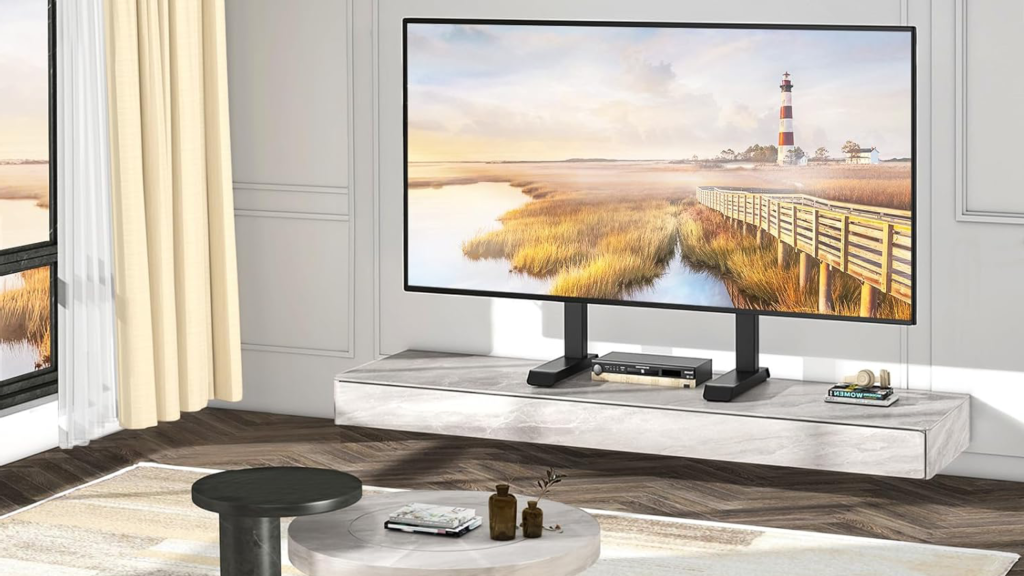Let’s face it – your living room has become command central for everything from Netflix binges to family game nights to showing off your style. And right at the heart of it all? Your TV. But what about what’s holding it up?
I’ve been researching TV stands lately (after a disastrous attempt to balance my new 55-inch on an old side table), and I realized most people don’t give these practical pieces enough credit. So let’s break down what TV stands actually are, why they matter, and how to pick one that works for your space.

So What Exactly IS a TV Stand Anyway?
At its most basic, a TV stand is furniture designed specifically to hold your television safely at the right height. But it’s also so much more than that.
A good TV stand pulls double (or triple) duty by:
- Supporting your TV at the perfect viewing height
- Storing all your media gadgets, game consoles, and remotes
- Managing that nightmare of cables we all pretend doesn’t exist
- Adding style points to your living space
- Keeping expensive electronics safe from toddlers, pets, and clumsy friends
TV stands have come a long way from the bulky wooden cabinets that used to hold those massive CRT televisions. Today’s options are sleeker and more versatile to match our thin screens and wireless technology.
Features You’ll Actually Use
Not all TV stands are created equal, but most good ones share some essential features:
A Surface That Won’t Collapse
This seems obvious, but you’d be surprised. Your stand needs a top surface wide enough for your TV’s base and strong enough to support its weight without wobbling. Nothing ruins movie night faster than a teetering television.
Storage That Makes Sense
Most stands offer some combination of:
- Open shelves where you can put devices that need airflow or remote access
- Cabinets with doors to hide the visual clutter (looking at you, tangled charging cables)
- Drawers for smaller items like controllers and remotes
- Specialized spaces for soundbars or center speakers
Cable Management That Actually Works
The best TV stands acknowledge reality: you have a million cables, and they’re ugly. Look for built-in holes, channels, or panels at the back for routing cables. This isn’t just about looks—it prevents tripping hazards too.
Mounting Options
Some newer stands come with built-in mounts or swivel mechanisms. These let you adjust your TV angle without moving furniture around (super helpful in open concept spaces or when you want to reduce glare).
Bonus Features Worth Considering
If you want to get fancy:
- Built-in LED lighting can add ambiance
- Electric fireplaces create a cozy focal point
- Adjustable shelves adapt as your tech changes
- Wheels make cleaning behind your TV possible
- Anti-tip straps are must-haves if you have kids or pets
Different TV Stand Styles for Different Spaces
Your perfect TV stand depends on your room, your stuff, and how you like to live. Here are the main types I’ve encountered:
1. Open Shelf Stands
Picture a modern, airy design with multiple open shelves. These look clean and contemporary, and they’re great for keeping devices cool.
Why you might want one:
- They’re usually affordable and lightweight
- You can grab your Xbox controller without opening doors
- They have a casual, modern vibe
Why you might not:
- Every bit of clutter is on display
- Your devices will collect dust faster
- Less storage for things you want hidden
2. Console or Cabinet Stands
These combine a flat top for your TV with enclosed storage underneath. They’re my personal favorite for hiding all the tech junk that accumulates.
Why you might want one:
- Great for keeping your space looking tidy
- Perfect for storing DVDs, games, and equipment
- Adds a polished, intentional look to your room
Why you might not:
- They take up more floor space
- Usually cost more than simpler designs
- Can feel heavy in smaller rooms
3. Corner TV Stands
Triangular-shaped stands designed to tuck into room corners. If you’re tight on space or have an awkward layout, these can be lifesavers.
Why you might want one:
- Makes use of often-wasted corner space
- Perfect for apartments or smaller bedrooms
- Leaves more wall space open
Why you might not:
- Limited selection of sizes
- Often have less storage
- Can be harder to find in matching styles
4. Swivel/Mounted Stands
These include a built-in mount that lets you rotate or tilt your TV. I love these for rooms where you might watch from different spots.
Why you might want one:
- Flexible viewing angles for different seating areas
- More secure than just setting a TV on top
- Modern, streamlined appearance
Why you might not:
- Installation can be more complicated
- Sometimes limits your storage options
5. Full Entertainment Centers
The grandparents of TV stands – large, statement pieces that frame your TV and provide tons of storage and display space.
Why you might want one:
- Makes your TV area a true focal point
- Tons of storage for media, books, and decor
- Creates a cohesive, designed look
Why you might not:
- Expensive (often $500+)
- Takes up significant wall space
- Overwhelming in smaller rooms
What They’re Made Of (And Why It Matters)
The material of your TV stand affects how it looks, how long it lasts, and how much you’ll pay:
Solid Wood
Traditional wood stands feel substantial and timeless. They work beautifully in homes with traditional, farmhouse, or craftsman styles.
The good: Extremely durable, ages well, adds warmth The bad: Expensive, heavy to move, can be damaged by moisture
MDF (Engineered Wood)
Most affordable TV stands use MDF with wood veneer or laminate finishes. It can look like real wood but costs much less.
The good: Budget-friendly, lots of style options The bad: Can chip or warp over time, especially if exposed to water
Metal
Metal frames with wood or glass shelves offer contemporary, industrial looks. They’re incredibly strong for their weight.
The good: Very durable, sleek modern appearance The bad: Can show scratches, sometimes feels cold or stark
Tempered Glass
Glass TV stands look sophisticated and help small spaces feel more open. Modern tempered glass is surprisingly strong.
The good: Elegant, makes rooms feel larger, easy to clean The bad: Shows every fingerprint and speck of dust
Why Not Just Use Any Old Table?
I tried this route. Trust me, a proper TV stand is worth it. Here’s why:
- Safety first: TV stands are designed with the right weight capacity and balance to prevent tipping.
- Viewing comfort: They’re built at the ideal height for watching without neck strain.
- Electronics-friendly: They provide proper ventilation to prevent overheating.
- Cable solutions: They include ways to manage and hide all those wires.
- Storage that makes sense: They have spaces designed specifically for media equipment.
When I finally replaced my makeshift solution with a real TV stand, my whole living room instantly looked more put-together.
Bottom Line
A TV stand might seem like just another piece of furniture, but it’s actually a hardworking essential that can make or break your entertainment setup. It keeps your expensive electronics safe, your space organized, and your room looking intentional rather than thrown together.
When shopping for one, consider:
- The size and weight of your TV
- How much stuff you need to store
- The layout and style of your room
- Your budget priorities (where can you compromise?)
- How long you want it to last
Whether you go for something simple and affordable or invest in a statement piece, the right TV stand makes watching, gaming, and entertaining so much more enjoyable. And isn’t that the whole point?

